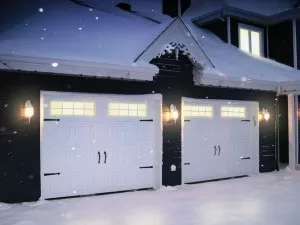
As the weather grows colder, you make the trek to the home improvement store to arm yourself with window film, door stops, and caulking to fill any new holes and cracks that may have formed over the summer. You know that winterizing your house is the best way to protect not only your family from the chills but also your utility bill from undue hikes.
Did you know that you should be taking similar steps for your garage? If you’ve never winterized your garage, you may be wondering what this task entails. Here are the top five ways to get your car’s house ready for the cold, just like you prepare your own home.
1. Install Insulation
It’s easy to overlook the use of insulation in your garage, but it can go a long way toward keeping warmth inside. If the big door isn’t insulated you may have to install a whole new insulated door. For the walls, consult your local professional contractor to find out the best options. Blown insulation offers excellent coverage and a qualified contractor can do the installation in just a few hours. Whether you choose blown-in or traditional rolls, insulation will add an effective layer of cold protection to your garage.
2. Replace the Weather Stripping
The long strip of rubber along the bottom of the garage door serves as protection against dirt, debris, bugs, and water that might enter underneath the door. This weather stripping breaks down over time, often cracking and tearing. Not only can this allow unwanted matter inside your garage, it can also prevent the door from closing correctly. Do a visual inspection of the stripping and if you detect any damage, replace it with new.
3. Cover Exposed Pipes, Outlets, and Switches
The pipes inside your home aren’t the only ones that can suffer from freezing and bursting. Insulating your garage’s pipes with fiberglass or foam will protect them from damage and save you from an unpleasant surprise by coming home one day to a flood in your garage.
Switches, outlets, and other exposed components in the garage allow in up to 5% more cold air in wintertime. When cold air enters your garage, it can pass right into your house, making you more uncomfortable and raising your heating bill. Covering these pipes and switches can reduce the amount of cold air that makes it into your garage and ultimately into your home.
4. Apply Waterproofing to the Floor
Water is a given in winter – snow and ice may form and melt repeatedly throughout the season, causing a potential flood inside your garage. Your car brings snow in on the tires, which then melts inside the warmer space. In addition, if you do experience a burst pipe the water could be voluminous. By waterproofing the floor you help minimize the potential damage from these moisture-related assaults.
5. Clean and Declutter
Throughout the spring, summer, and fall, garden tools, lawn mowers, boxes of extra items and sometimes even furniture gets relegated to the garage – crowding the space and preventing you from actually parking your car inside it. Winterizing your garage is the perfect opportunity to install new shelving and storage containers to organize all the things that have collected over the warm seasons. Donate unwanted items and throw away anything useless. For more great ideas, read our blog on reclaiming garage space.
Once all the clutter is out of the way and you have a clear view of the garage door track, inspect it for any dirt or debris that may have collected there over the summer. Ensure that the mechanism is oiled and running smoothly. This way you won’t have to fuss with maintenance on the door in the middle of the bitter cold.
Schedule Maintenance and Repair Services
Once you’ve complete the above tasks, you’ll be ready to take on winter in full force. If you need some help with replacing or repairing your garage door or any of its components, call Caspersen Garage Doors. Our qualified professionals will get your garage door working like new no matter what season it is.
For additional information on garage maintenance and upgrades, check out the rest of our blog.

Add new comment